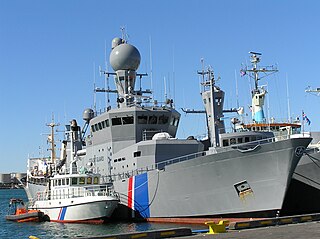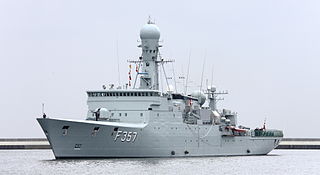
The defence of Greenland is the responsibility of the Kingdom of Denmark; the government of Greenland does not have control of Greenland's military or foreign affairs. In the history of Greenland there have been many changes of presence regarding who is in charge of the security of Greenlandic people and its land.

Search and rescue (SAR) is the search for and provision of aid to people who are in distress or imminent danger. The general field of search and rescue includes many specialty sub-fields, typically determined by the type of terrain the search is conducted over. These include mountain rescue; ground search and rescue, including the use of search and rescue dogs ; urban search and rescue in cities; combat search and rescue on the battlefield and air-sea rescue over water.

The Royal Danish Navy is the sea-based branch of the Danish Armed Forces force. The RDN is mainly responsible for maritime defence and maintaining the sovereignty of Danish territorial waters. Other tasks include surveillance, search and rescue, icebreaking, oil spill recovery and prevention as well as contributions to international tasks and forces.

USCGC Triton (WPC-116), a steel-hulled, diesel-powered Thetis-class patrol boat of the United States Coast Guard, was the fourth commissioned ship of the United States to be named for Triton, a Greek demigod of the sea who was the son of Poseidon and Amphitrite. She served almost simultaneously with the submarine of the same name. Today, she serves as a tour boat in New York City for Circle Line Sightseeing Cruises, and carries the name Circle Line XVII.

USS Triton (SSRN/SSN-586), the only member of her class, was a nuclear powered radar picket submarine in the United States Navy. She had the distinction of being the only Western submarine powered by two nuclear reactors. Triton was the second submarine and the fourth vessel of the United States Navy to be named for the Greek god Triton, At the time of her commissioning in 1959, Triton was the largest, most powerful, and most expensive submarine ever built at $109 million excluding the cost of nuclear fuel and reactors.

The Royal Navy's T class of diesel-electric submarines was designed in the 1930s to replace the O, P, and R classes. Fifty-three members of the class were built just before and during the Second World War, where they played a major role in the Royal Navy's submarine operations. Four boats in service with the Royal Netherlands Navy were known as the Zwaardvisch class.

HMS Thetis (N25) was a Group 1 T-class submarine of the Royal Navy which sank during sea trials in Liverpool Bay, England on 1 June 1939. After being salvaged and repaired, the boat was recommissioned as HMS Thunderbolt in 1940. It served during the Second World War until being lost with all hands in the Mediterranean on 14 March 1943.

The Icelandic Coast Guard is the Icelandic defence service responsible for search and rescue, maritime safety and security surveillance, national defense, and law enforcement. The Coast Guard maintains the Iceland Air Defence System which conducts ground-based surveillance of Iceland's air space and operate Keflavik airbase. It is also responsible for hydrographic surveying and nautical charting.

ICGV Týr is an Ægir-class offshore patrol vessel and the former flagship of the Icelandic Coast Guard. The ship was built by Dannebrog Værft in Denmark in 1974–1975 and entered service in 1975. Týr was for a time the second largest ship in the Icelandic Coast Guard and participated in the Third Cod War. The ship conducted patrols, search and rescue, fishery inspections, general law enforcement and counter-terrorism operations in the Icelandic exclusive economic zone and the waters of the surrounding territories, such as Greenland and Jan Mayen. Týr was decommissioned in 2021 and sold in 2022.

The Thetis-class ocean patrol vessels or ocean patrol frigates, also called Stanflex 3000, is a class of large patrol vessels built for the Royal Danish Navy. The class comprises four ships, all built and commissioned in the early 1990s. The ships' tasks are mainly maintenance of sovereignty, search and rescue, fishery inspection and support to local authorities. The operation areas are normally Greenland and the Faroe Islands, but the vessels also operate near Iceland on transit between Greenland and the Faroe Islands, and near Denmark.
Northern Viking is an annual NATO exercise held in Iceland. The exercises were held biennially until 2006 when the frequency was increased. The purpose of the exercise is to test the capabilities of Iceland and its NATO allies, as well as increase the readiness of the forces involved and their inter-operability.

The Havmanden class was a class of six submarines built for the Royal Danish Navy from 1911 to 1914. Also later known as the A class, the boats were designed by the Austro-Hungarian firm Whitehead & Co. of Fiume. The first three submarines were built by the company, while the remaining three were constructed under license in Copenhagen.
The North Sea trawler MS Golfo Azzurro was launched in 1987 as the Maarten Cornelis, and was the first trawler in the Netherlands equipped with the EUR SumWing. From 2016-2017 it was chartered by the Spanish NGO Proactiva Open Arms and was used for search and rescue operations near Libyan waters.

SMS Thetis was the fourth member of the ten-ship Gazelle class of light cruisers that were built for the German Kaiserliche Marine in the late 1890s and early 1900s. The Gazelle class was the culmination of earlier unprotected cruiser and aviso designs, combining the best aspects of both types in what became the progenitor of all future light cruisers of the Imperial fleet. Built to be able to serve with the main German fleet and as a colonial cruiser, she was armed with a battery of ten 10.5 cm (4.1 in) guns and a top speed of 21.5 knots.

The Joint Arctic Command is a direct Level II authority in the Danish Defence. Joint Arctic Command's primary mission in peacetime is to ensure Danish sovereignty by monitoring the area around the Faroe Islands and Greenland. The command also handles tasks such as fisheries inspection, search and rescue (SAR), patient transport and other tasks that support the civil society. In short, the Joint Arctic Command handles military tasks, coast guard duties and disaster response - all in one organisation.
Operation Mare Nostrum was a year-long naval and air operation commenced by the Italian government on 18 October 2013, which rescued at least 150,000 migrants on the dangerous Mediterranean sea crossing. The operation ended on 31 October 2014, and was superseded by Frontex's Operation Triton.

Operation Triton was an operation conducted by Frontex, the European Union's border security agency. The operation, under Italian control, began on 1 November 2014 and ended on 1 February 2018 when it was replaced by Operation Themis. It involved voluntary contributions from 15 other European nations. Voluntary contributors to Operation Triton included Croatia, Iceland, Finland, Norway, Sweden, Germany, the Netherlands, France, Spain, Portugal, Austria, Switzerland, Romania, Poland, Lithuania and Malta. The operation was undertaken after Italy ended Operation Mare Nostrum, which had become politically unpopular and costed the Italian government €9 million per month for an operation that lasted 12 months. The Italian government had requested support from the other EU member states, but the request was declined.

Nesskip hf. is an Icelandic shipping company that runs affreightment services based in Reykjavík. The company was established on 27 January 1974 in Seltjarnernes and was founded by a group of shipping and bulk transport enthusiasts, led by Captain Gudmundur Asgeirsson, who was the first managing director of the company. It is one of Iceland's largest bulk transporting firms. According to Bloomberg it "provides a range of shipping-related services as ship owners, ship brokers, port agents, and transport and chartering consultants", and serves "cruise liners, seismic-research vessels, reefers, tankers, and dry cargo vessels and foreign deep sea fishing ships" as a port agent. The company Nesskip is valued at approximately 240 Million Norwegian Krones (KON); approximately US$23 million. Nesskip purchased its first bulk carrier in February 1974, named the Suðurland and specialises in bulk transport of goods which has been at the fore front of the company's operations for over 40 years. The company deals with the transportation of fishmeal, steel products, construction materials, cement, timber, pumice, coal, gravel, ferrosilicon, and salt as well as other FOSFA cargo. In 1977, Nesskip began to develop a close working relationship with the company Wilson ASA, who specialise in the management of shipping services. It is a member of the international shipping organisation Baltic and International Maritime Council (BIMCO). In 2006, Norwegian shipping company Wilson EuroCarriers acquired a majority share (51.6%) in Nesskip resulting in a change of ownership.

Sif, also known as TF-SIF, is an Aerospatiale SA365N Dauphin 2 helicopter used by the Icelandic Coast Guard from 1985 to 2007. It took part in several high profile rescue operations around Iceland during its 22-year career and is credited to have been involved in the rescue of around 250 lives. It is named after Sif, the golden-haired goddess from Norse mythology and is the third Coast Guard aircraft to bear the name. Since 2008, it has been on display at the Icelandic Aviation Museum.



















